PRESERVING A MILITARY LEGACY FOR FUTURE GENERATIONS
The following Reflections represents LTC Don G. Fite’s legacy of his military service from 1961 to 1987. If you are a Veteran, consider preserving a record of your own military service, including your memories and photographs, on Togetherweserved.com (TWS), the leading archive of living military history. The following Service Reflections is an easy-to-complete self-interview, located on your TWS Military Service Page, which enables you to remember key people and events from your military service and the impact they made on your life. Start recording your own Military Memories HERE.
Please describe who or what influenced your decision to join the Army.

I was in my 5th year of college, and I knew I was not going to be able to complete it. The Dean advised me to “find myself by entering the service,” which made sense as the draft would be coming for me, so rather than take my chances with that, I decided to choose my own path by joining.
Whether you were in the service for several years or as a career, please describe the direction or path you took. What was your reason for leaving?
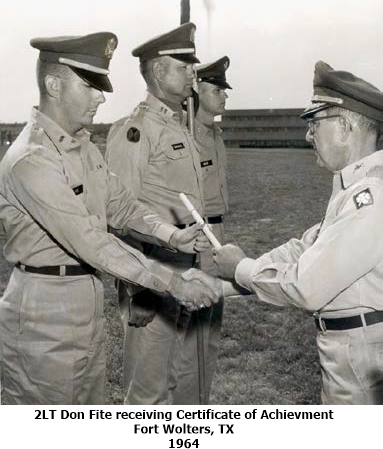
I wanted to fly. I actually tried to join the Air Force first, but I had pierced eardrums, so they wouldn’t take me, and that is how I ended up choosing the Army. When I joined, I had also submitted a packet for Officer Candidate School (OCS), and the Group Sergeant Major took it upon himself to lower my score, thus delaying my entry into OCS. With the assistance of CWO Teagarden, I was able to re-test for OCS, and Mr. Teagarden submitted my scores himself, thereby allowing me to get into OCS on 6 Aug 1962.
I still wanted to fly, preferably fixed-wing aircraft, but the Army needed rotary-wing aviators. I entered the Officer Rotary Wing Aviator course on 18 May 1964 and graduated on 1 Jan 1965. I finally got my chance to fly. In Vietnam, I flew the UH-1, Huey, where I flew medevac, transport, and supply missions, some harrowing and few “routine.” One never forgets a year of combat flying Hueys “Anytime, Anywhere, Any mission” in Vietnam…
For the next year and a half, I was both pilot and maintenance instructor at the US Army Aviation School at Fort Rucker, and then it was back to Vietnam, just days before the Tet Offensive began, where I flew Chinooks; for the “Pachyderms.” Again, most missions were harrowing due to the nature of war.
I was then sent to Fort Carson, CO, as a Field Artillery Officer, and I was promoted to Major in 1970. This was my first non-aviation-related assignment, so I needed to do a lot of training. Also, I was able to attend Aero Company Fixed Wing Flight School and obtained a civilian license for fixed-wing aircraft.
From Sep 1971-May 1972, the Army supported me in attending the University of Nebraska, and I earned my Bachelor of Science in General Engineering followed by ten months of instruction at the Command & Staff College and finally two months of AH-1 Cobra flight training in mid-1973 at Hunter Army Air Field in Georgia.
From mid-1973 through late 1974, I was a company commander at Fort Campbell for the same Chinook company I served in during my second tour in Vietnam. I then went on to command A Battery, 77th Artillery Group, which was my actual AOC. until August 1975.

In late 1975 and through half of 1978, there was a big change in my career in that I got assigned to HQ, Department of the Army, as a Staff Officer at the Pentagon in Washington, DC. This job still had me connected to Aviation but in a different manner. I was assigned as the Department of the Army System Coordinator (DASC) in the Weapon Systems Aviation (WSA) Division. In order to maintain my flight proficiency, I was attached to Davison Army Airfield at Fort Belvoir and was able to obtain my OH-58 (Kiowa) flight certification.
For the next two years, I was at MILPERCEN as the Manager of the Project Manager Development Program with additional duties, of course. My involvement here helped in a way for Aviation to take its place as its own branch alongside Infantry, Armor, Transportation, etc.
My follow-on assignment in 1980-1981 was that of the Battalion Commander of the 119th Aviation Battalion at Camp Humphreys, South Korea, where I had the additional duty of Airfield Commander. Unfortunately, illicit activities were rampant, but I soon got those under control. Since it had been six years since I had flown any helicopter except the OH-58, I made arrangements with CW4 Tom Glass to get some training on the CH-47. Still, there was not enough time, so I stuck with the Huey, making occasional trips to Taegu, the DMZ, and Seoul, and managed to get simulator training in quarterly. Unfortunately, this was the last time I got to fly.
Upon my return stateside, I attended the Program Management Course at the Defense Systems Management College from July-Dec 1981. I graduated with a superior rating which took me to my last two assignments, which were at the Pentagon and then in Alexandria, VA.

While at the Pentagon (Dec 1981-Jan 1983), I worked in the Plans & Integration Div of Strategy Plans & Policy Directorate, a newly set up office. This was a political desk job that I was a misfit for, and with not sharing any views, my boss did not particularly care for me.
Fortunately, my final assignment was much better. This was at the Systems Evaluation & Test Div, Product Assurance & Test Directorate, DARCOM [Development & Readiness Command], Alexandria, VA. Note: DARCOM became AMC [Army Materiel Command] in 1984. I was the Team Chief responsible for the development, implementation & maintenance of a highly structured Systems Assessment/Disciplined Review program which periodically evaluates the performance of fielded ground combat & munitions systems.
If you participated in any military operations, including combat, humanitarian and peacekeeping operations, please describe those which made a lasting impact on you and, if life-changing, in what way?
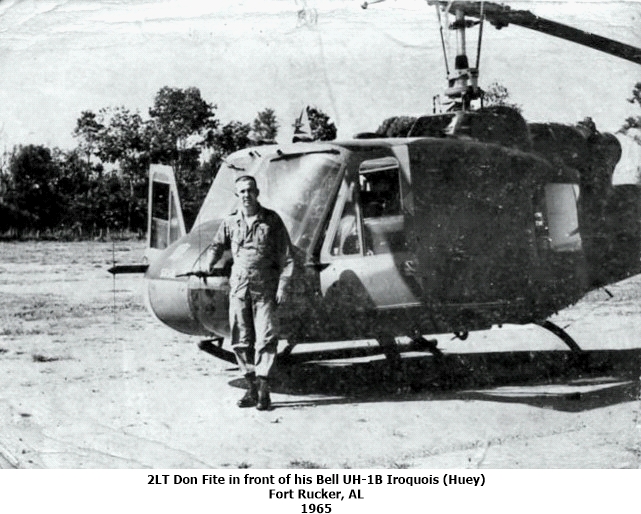
A bundle of things made an impact. What we did (and didn’t) do in Vietnam brought home the cruciality of what national defense means to preserve OUR nation. Working with different aircraft and weapons in various stages (e.g., Huey, Cobra, Chinook, rockets, Kiowa Warrior) and in different facets (combat, peacetime, maintenance, fielding) as well as the larger Army weapons systems life cycle (development and testing thru production and fielding; budgets and contracts) gave me a balanced reality-picture and shaped focus on end-outcome being worthwhile.
Did you encounter any situation during your military service when you believed there was a possibility you might not survive? If so, please describe what happened and what was the outcome.
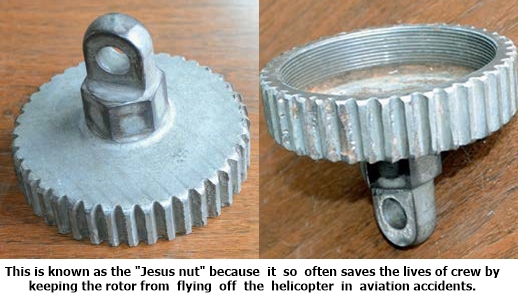
I had to pick up a downed Air Force pilot on a MEDEVAC mission just outside a Viet Cong camp. I was able to retrieve him, but I had to fly low and slow under mortar fire to depart. This led me to land in the mouth of a cave, and I was able to observe a major Viet Cong hospital and a myriad of tunnels which I promptly reported when I returned to base. The cave was immediately bombed.
Returning from a “Sneaky Pete” mission, my Huey was shot down on the Laos side of the Vietnam-Laos-Cambodia boundary junction. Myself, my co-pilot and a badly injured crewmate went down with the aircraft. We hid from the Viet Cong until nightfall. It took us two days of hiding and walking until we reached the nearest Army camp at Dak To. My injured crewmate died along the way, but I had carried him out.
The Viet Cong opened fire on another mission when I landed the Huey. A bullet shattered my visor, but I was uninjured. Unfortunately, my co-pilot was also struck and killed.
Surviving these near-death incidents brought a realization that God must have a purpose for me to live and that I had better think about the larger purpose in all my future activities.
Of all your duty stations or assignments, which one do you have fondest memories of and why? Which was your least favorite?
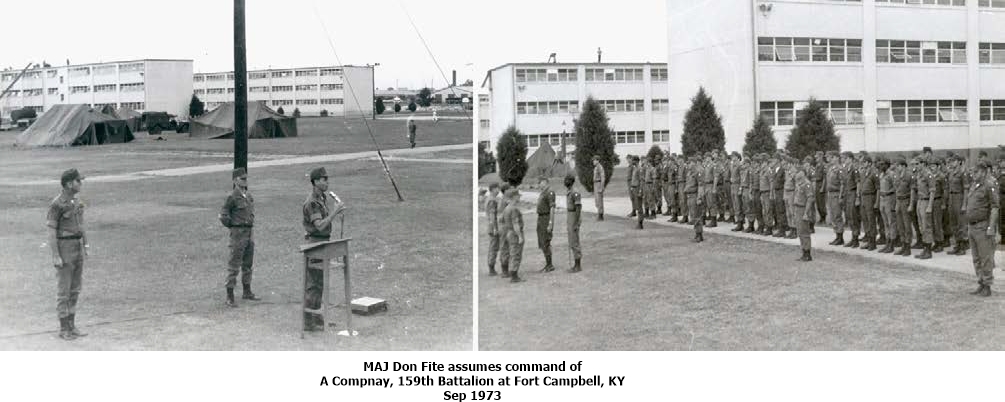
Most Favorite:
All in all, the time at Ft. Campbell (1973-75) when I was A/159th company commander followed by Cobra A Battery commander was the best. Corollary to that was being DASC in the Pentagon and making some crucial things happen directly helped “save Army Aviation” in the eyes of COL Bill Crouch (my boss and later the Aviation Test Board Director at Ft. Rucker AL) and BG Canedy, the Army Aviation Officer.
Least Favorite:
1982, the Pentagon assignment in DCSOPS Plans & Policy: The lousy boss was just that, and I sloughed that off just as with others, but the fact that the entire organization’s “mission” was political. Trying to wrest weapon systems acquisition and management from DCSRDA (the only place that acquisition process and funding were understood well enough to make sure these essential systems materialized) meant that what I was tasked to do work against actual Army purpose.
From your entire military service, describe any memories you still reflect back on to this day.
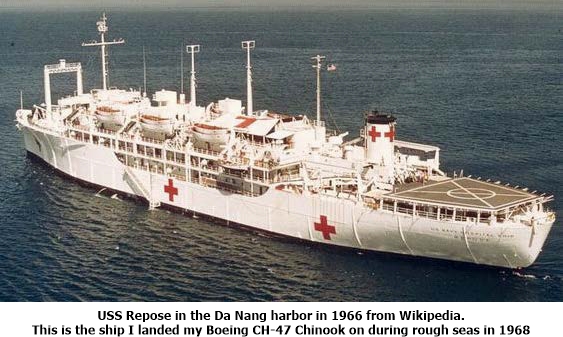
I flew one MEDEVAC flight to evacuate a near-death pregnant woman to an Army hospital. The trip was successful because both the mother and baby lived, and I was then able to return them to their village.
I received the Individual Vietnamese Gallantry Cross due to Chairman Nguyen Van Thieu.
I was airlifting civilian refugees that the Viet Cong was overrunning. I picked up 25-30 passengers, mostly women, and babies. Some refugees grabbed onto the skids but could not hang on, but some were able to and made it out.
During my second tour in Vietnam, I picked up about 24 casualties in my Chinook that needed to be transported to the USS Repose hospital ship. I was able to safely offload them even though there was barely space for my chopper to land in stormy conditions that kept the landing pad heaving.
It is being able to finish my engineering degree.
Getting the new Chinook hanger built in early 1974 at Fort Campbell so the aircraft could actually fit in it and be serviced.
What professional achievements are you most proud of from your military career?
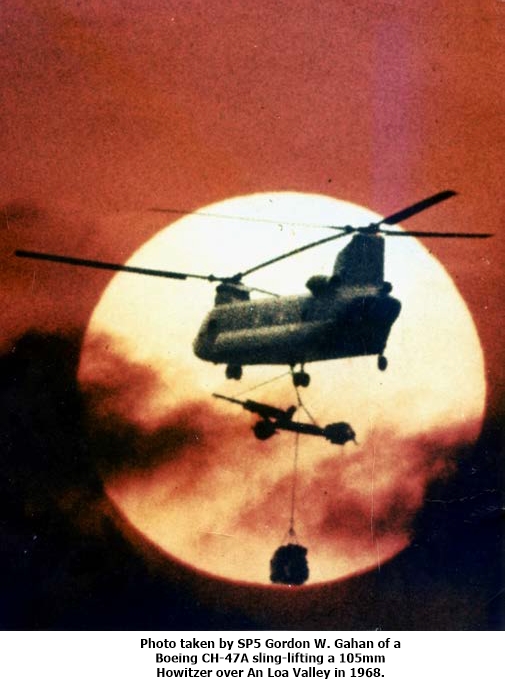
The ground was laid for my pride during my 2nd Vietnam tour, with accomplishments as the only known OJT-trained CH-47 maintenance officer. This pride carried forward to my time as the Commander of A/159th at Ft. Campbell, where I was cited for = First strategic deployment of six CH-47s in Air Force C-5As; assuming the mission to support the entire Division during 3rd Brigade ORTTs, and A/159th achieving record-high readiness rate for Chinooks Army-wide, culminated when serving as 119th Aviation Bn commander in Korea, where I brought them from last place (below 70% readiness) to stay in the first place (above 90%), unheard of in Army history.
GEN Wickham’s personal MSM citation said it well: “Under his guidance, the quality of life of all soldiers has dramatically improved, as have the daily operations, aircraft and vehicle maintenance, individual and unit training, and overall combat readiness. Most impressive was the Battalion’s readiness rate, the highest of any like unit in the United States Army.” Another point of pride is knowing my DASC service brought the AH-1S Cobra program to successful acceleration, which was a significant factor in holding the Russians at bay in the Cold War.
Of all the medals, awards, formal presentations and qualification badges you received, or other memorabilia, which one is the most meaningful to you and why?
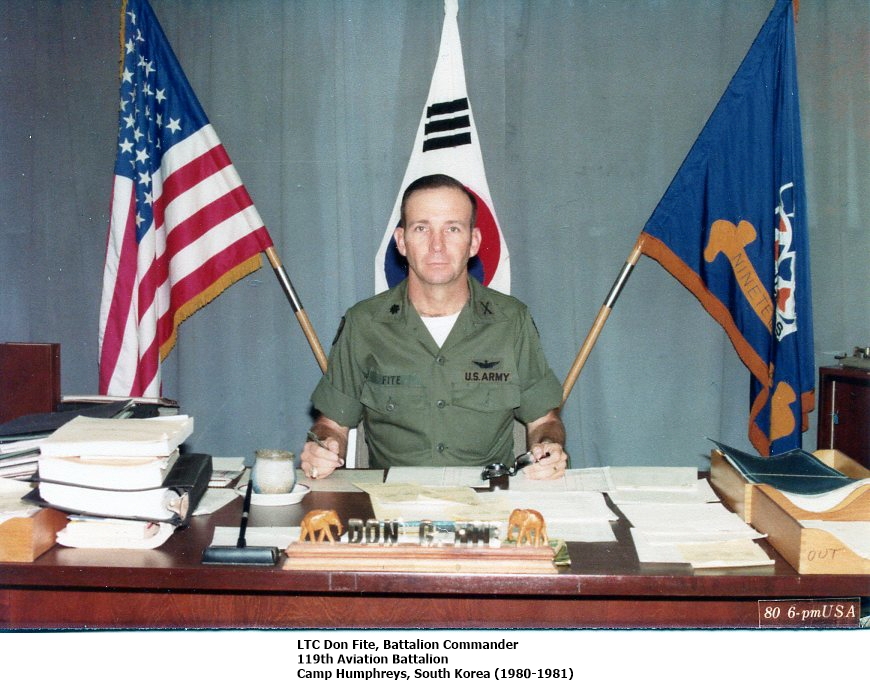
None of mine, really. The most meaningful to me was defending a wrongfully accused SGT [early in 1st Vietnam tour] and getting the Legion of Merit awarded to SP5 John W. Cain, III, the legal specialist, without whose help the many security issues that I faced in Korea would not have been resolved and whose diligent work with the pilot’s Aircraft Accident Reports would have continued to be kicked back and delayed.
Which individual(s) from your time in the military stand out as having the most positive impact on you and why?
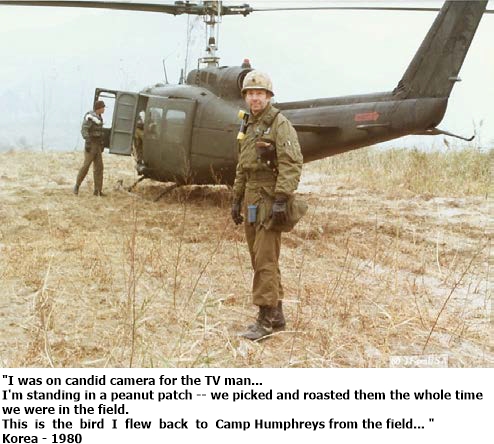
MSGT “Gasmask” Odom, 1961-62 at Ft. Riley KS. He was an “old-timer” WWII vet who was balanced, wise, and Army-purposeful in all he did. CW2 Hu “Dusty” Rhodes, operations officer (2nd Vietnam tour) who always gave all, zeroing in on what was needed and who was where it could be done. That’s how he died. MG Sidney Barry, who was the kind of general officer one always hoped for, focused on the mission and how to make things happen rather than nitpicks and politics and ego.
List the names of old friends you served with, at which locations, and recount what you remember most about them. Indicate those you are already in touch with and those you would like to make contact with.
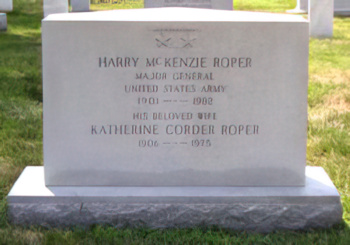
CW2 Larry Storm – gun pilot
CW2 Tom Glass – instructor pilot. We flew UH-1s during my first tour in Vietnam, and then he was my Safety and Standardizations “guy” during my tour in Korea from Jun 1980-Jun 1981. No contact since Korea.
CPT Bill Graves – OV-1 Mohawk pilot that was shot down in South Vietnam. I was assigned as the escort officer at the request of his widow.
CPT Art Lord – flight school classmate; shot down in South Vietnam.
CPT John A Rollow – served as an assistant S-3. He really wanted to be a dentist, and I was able to assist in him getting to do so. Ten years later, while I was stationed at the Pentagon, I went to see the dentist, and lo-and-behold, it was John.
MAJ Bill Hunt – we attended a Thermal Dynamics class together and eventually held a study group/tutoring together for their classmates.
MG Sidney Barry – 101st Airborne Division Commander at Fort Campbell from 1973-1974.
MAJ Bill Graham – took over as company commander when I left A/159th.
BG (then COL) Harry McKenzie Roper, Jr – Group Commander of the 101st Airborne Division at Fort Campbell.
MAJ Maurice Reed – C/159th company commander at Fort Campbell. The last contact was 2019, address Brandon MS.
COL Bill Crouch – Weapon Systems Aviation Division Chief.
CPT Bell – HHD, 19th Aviation Battalion *
MAJ Tom Edwards – 271st Co/19th AVN BN *
MAJ Walter “Boss” Moss – 213th Co/19th AVN BN *
MAJ Jerry Sheetz – 201st Det./19th AVN BN *
- Lost contact after Korea, but these four were fine company commanders!
MAJ Marty Carmona – A-511 Airfield commander. Sometime after his retirement, he went to work for Boeing Aircraft and became acquainted with my wife Judy’s brother Sam Hurt, Chief Engineer-Rotary Wing at Boeing.
SP5 John W. Cain, III – I was able to get him awarded the Legion of Merit due to his exemplary assistance with the security issues (general thievery, prostitution, POL and PX thefts, security leaks) faced during my tenure in Korea.
COL Ron Hill – he had been a co-worker in DSCRDA and later my boss at Systems Evaluation & Test Division, Product Assurance & Test Directorate. Still in contact.
COL Ivar W. Rundgren, also WSA Division Chief in the Pentagon and later wife Judy’s boss as Army Scout Helicopter Project Manager in St. Louis. Still in contact. He (age 91) is currently fighting liver cancer and remains in wide contact with the “WSA gang” via email. Prayers appreciated.
Can you recount a particular incident from your service, which may or may not have been funny at the time, but still makes you laugh?
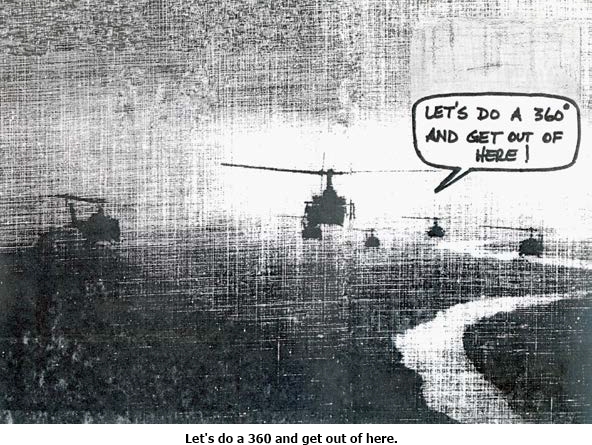
Fortunately, this story was funny then and is still funny. During my first tour in Vietnam, I was on a Medevac mission to pick up a downed pilot. We landed in a fairly open area, with no visible VC or any gunfire. The downed pilot was pretty scared and wild-eyed as he burst up out of the grass and ran hard for the open doors of the Huey. When he got close, he made a soaring dive through the open door — and ended up soaring all the way through to land on the other side of the Huey! The crew and I broke up in laughter, helping him climb back inside and shaking so hard the helicopter also shook as we rose into the air and headed back to base.
Another funny then and funny now story. Before my first tour in Vietnam ended, I was placed in charge of the mess hall and Officer’s Club, both of which had been poorly managed. Due to no one’s fault, one of the problems that we had is that there would be weevils in the bread flour. I checked with the flight surgeon, and he said they would be “nothing but baked protein,” so we continued to use it. Well, one night, a newly arrived officer came in and ordered a meal with hot biscuits. When he opened a biscuit to butter it, he was horrified and chewed out the waiter. The waiter signaled for the Manager to come to the table, and when I asked the problem, the newbie yelled vehemently, “This bread has bugs!!!!” Don put his finger to his lips, saying, “Shhhhh!!!! Or others will hear you! These are certified protein, and everyone else will want some too!!!” The rest of the patrons had a good laugh and resumed eating.
During my 2nd tour in Vietnam, I had a high-ranking official in my Chinook who was responsible for some of the troops being delivered. He was pretty nervous and became more agitated as the mission progressed. When I and the other three helicopters had finished dropping the troops and supply loads, we had to coordinate our reverse maneuvers to return to base. My passenger couldn’t stand it anymore and burst out, “Let’s do a 360 and get the hell out of here!”. He did this via the radio, which meant everyone could hear him, and they broke up in laughter.
While I was the Department of Army System Coordinator (DASC) in the Weapons Systems Aviation Division (WSA), I worked on a project for a Mast Mounted Sight for the UH-1 Huey and needed to procure funding for it. During the meeting, I demonstrated the potential benefit of this project performed for the top brass. I had enlisted the help of Dr. Fernanski and some mechanics at Davison Army Airfield at Fort Belvoir. They mounted the TV sight above the rotor of the Huey, which gave a live feed that was viewed on a TV monitor, and there was nothing but ho-hum terrain shown. When the pilot was in his ideal position, he radioed me and said he was ready. In turn, I said to the attendees, “Ladies and Gentlemen, please look at the TV and smile – you’re on Candid Camera!” Astonished, they could see themselves standing around, peering, and pointing, but couldn’t locate the Huey by sight or sound. Further, when the Huey rose up into view, it was much closer and in the opposite direction of where they were convinced it was. Funding was quickly approved for the Mast Mounted Sight project, and it ended up on the Army’s improved scout helicopter, the OH-58 Kiowa Warrior.
What profession did you follow after your military service and what are you doing now? if you are currently serving, what is your present occupational specialty?
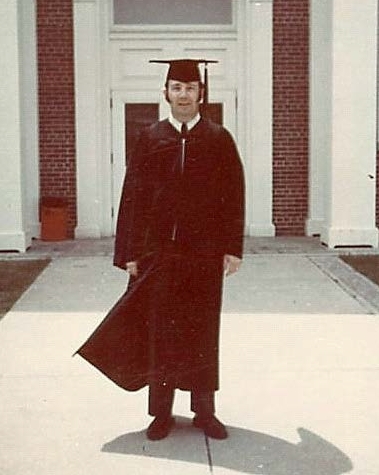
I never held another paying job per se, but sure did work! My wife Judy and I built our dream log home here in Colorado, and for three decades, I have maintained it. In parallel, I served as both logistician & hand-crafted with wife-owner of our Colorado Specialties business for the next two decades.
What military associations are you a member of, if any? What specific benefits do you derive from your memberships?
In what ways has serving in the military influenced the way you have approached your life and your career? What do you miss most about your time in the service?
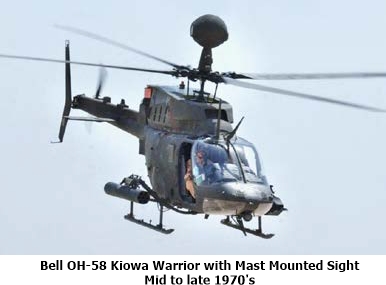
Focus and purpose while loving life and freedom!
Based on your own experiences, what advice would you give to those who have recently joined the Army?
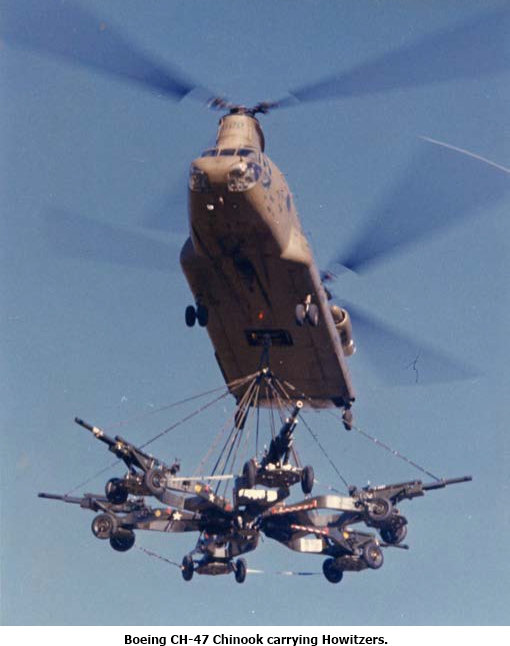
Think hard about what you believe in and what you want, long-term. Work for it.
In what ways has togetherweserved.com helped you remember your military service and the friends you served with?
I applaud the range of info it provides, including views and stories, and the fact that I can look up lots of information! Greatly appreciate that, no matter who or how many of the unsung nature of “news,” TWS makes sure that thousands who have served can be remembered.
In particular, I am deeply thankful for the help provided by Monica J. Primus of the Profile Assistance Team. Over the past 18 months, she has enabled me to find info and fill in the holes of my sporadic record files and has handled the actual format and TWS input on my behalf. It couldn’t have happened without her.
PRESERVE YOUR OWN SERVICE MEMORIES!
Boot Camp, Units, Combat Operations
Join Togetherweserved.com to Create a Legacy of Your Service
U.S. Marine Corps, U.S. Navy, U.S. Air Force, U.S. Army, U.S. Coast Guard
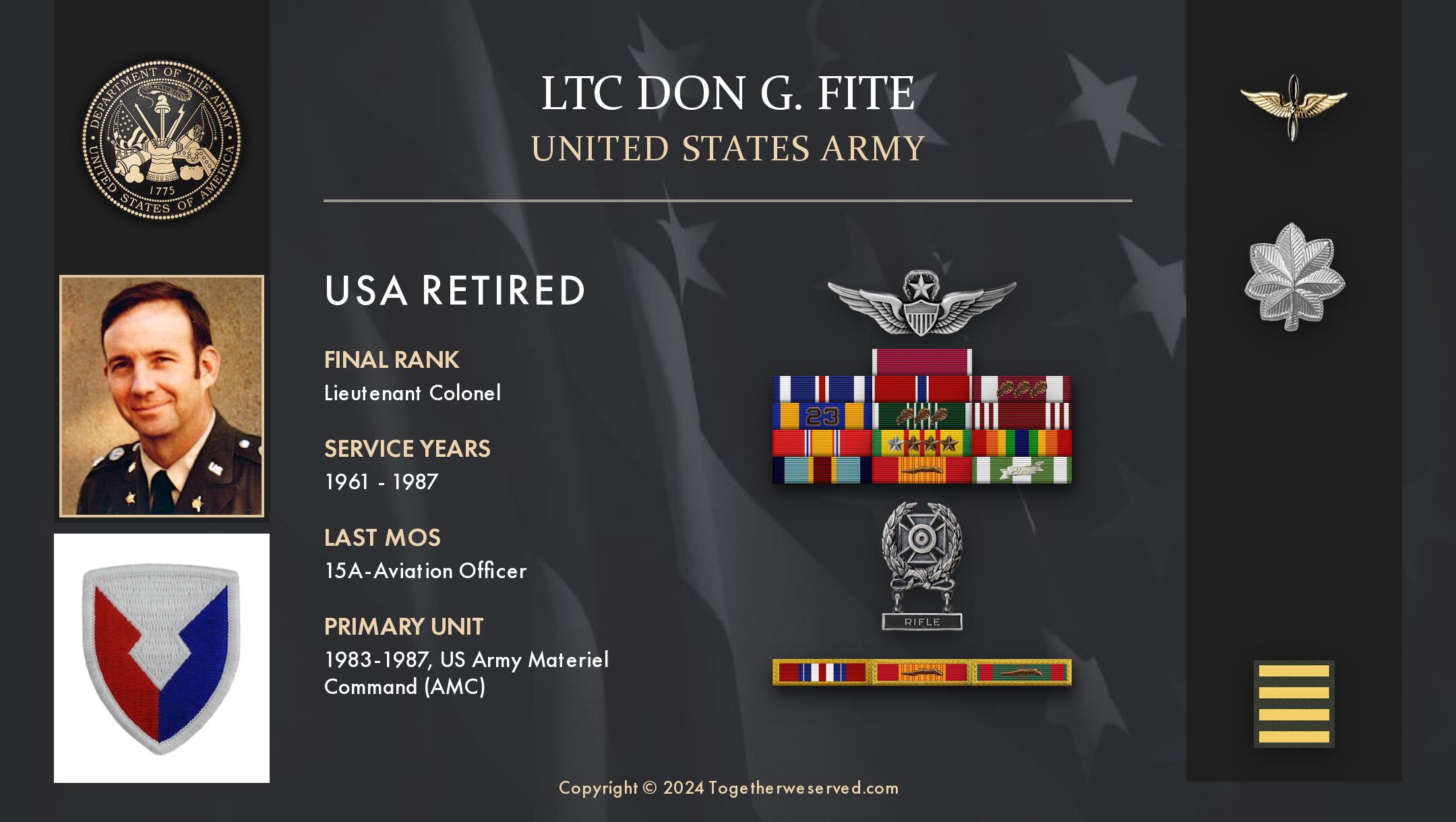
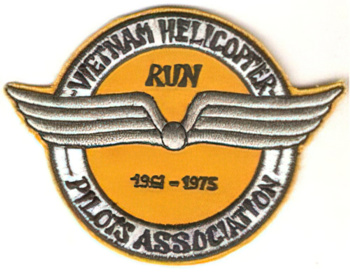
0 Comments